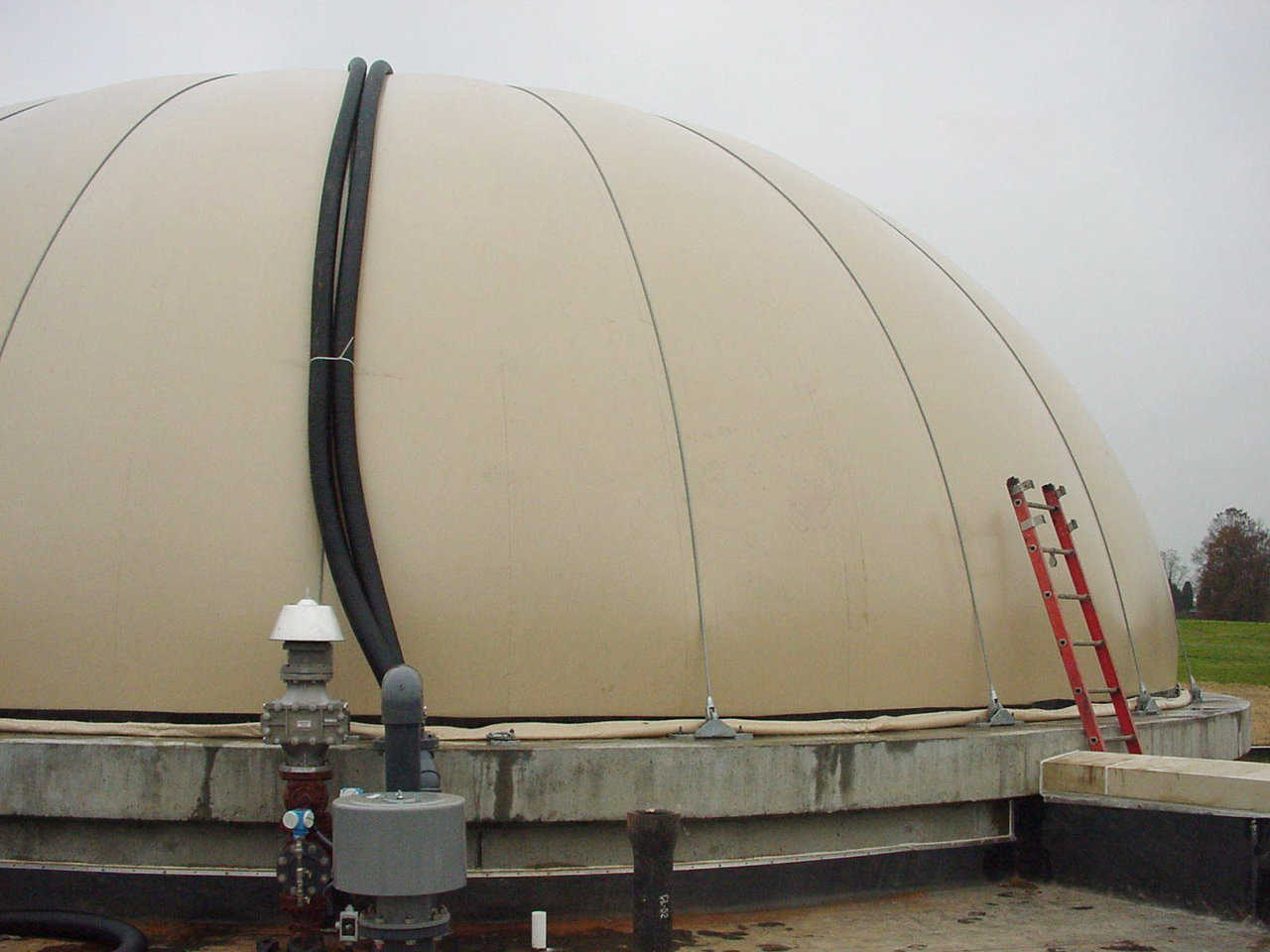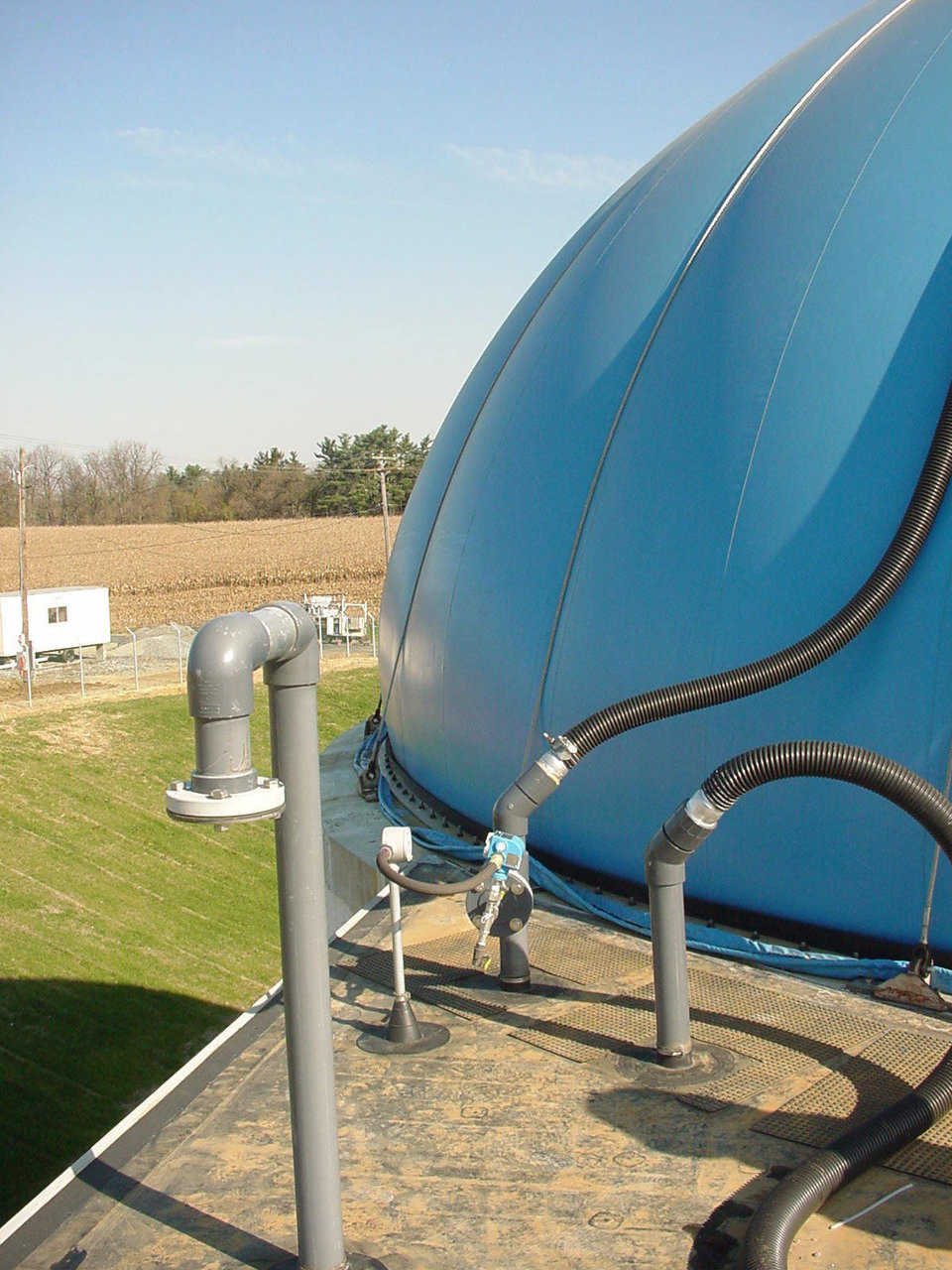Airforms in Waste Treatment
Switzerland has a small one with a 37.75’ diameter. Chile has a large one with a 90.2’ diameter. And hundreds of others with various diameters serve in many installations throughout the U.S.
We’re talking about Monolithic Airforms, manufactured for USFilter at Bruco, our Airform factory in Italy, Texas.
In 1990, Siemans Water Technoligies, a leading global provider of commercial, industrial, municipal and residential water and wastewater treatment systems, organized USFilter. Since then, a significant number of its facilities include USFilter’s Dystor® Gas Holder Systems with Monolithic Airforms.
According to USFilter, their “Dystor system is a gas holder design that uses a dome-shaped, engineered membrane system to store methane gas, provide for sludge storage, and prevent odors.” (Bulletin U.S.F.315-262R2 at www.usfilter.com)
James Medhurst, anaerobic digestion product manager now in his fourteenth year with USFilter, said, “In our Dystor System, we use two Airforms that we call membranes, an inner one or gas membrane and an outer one or air membrane.”
Donald Garrison, division manager of Monolithic Airform Manufacturing, said, “Those membranes are made to USFilter’s specifications so that they fit tightly around the circumference of a waste digestion tank.”
The Process
Anaerobic digestion, defined by USFilter as a “sludge stabilization process” that converts organic material to methane and carbon dioxide, takes place in the airtight tank. Medhurst compared it to the process happening in our stomachs that digests food and produces gas.
He said, “As waste converts to gas – usually methane – the inner gas membrane inflates and rises.” But the methane stays in the tank, under the gas membrane, until the desired amount of methane is produced. Then the methane is released, and as that happens the gas membrane descends. But you can’t see anything the gas membrane does because of the dome-shaped, outer air membrane over it.
“That outer air membrane is continually under pressure – 25 inches or more of water column pressure. That’s a lot of pressure,” Medhurst said.
The Design
Because of the pressure it must continually endure, the air membrane has a cable system. Medhurst said, “It’s restrained by cables that run from the tank diameter all the way up to the center hub. The air membrane lies just beneath those cables.”
According to Garrison, Monolithic Airforms uses heavy, strong fabric for the Dystor membranes. He said, “We use 31-ounce fabric. You wouldn’t want some light weight 14 to 22 ounce material. That would never hold. The fabric for the gas membrane must be able to stand the chemicals and stuff they put in the treatment tank. Some fabrics would get eaten up by the gas or chemicals. When it’s deflated, that gas membrane lies right on top of the sewage.”
USFilter provides the design specifications for the membranes they want. Garrison said, “They give us a blueprint with diameter, height, and number and location of cables. We put reinforcement strips on the air membrane so that the cables won’t wear through the fabric.”
Membranes range in diameter from 25 to 110 feet. Their diameters match the diameters of the tanks they are made for. “The gas membrane is actually three percent larger than the air membrane,” Garrison said, “because it needs the slack since it rises and descends.”
Lifespan
Strength and durability are equally important for the outer air membrane. Garrison said, “USFilter puts a lot more pressure on the Airforms than anybody else does. They use up to 25 inches of continual pressure; we don’t get close to that with the Airforms for Monolithic Dome structures.”
Asked about the lifespan of the membranes, Medhurst said that USFilter’s oldest units date back to 1986 and ‘87. "We’re claiming a 20-year life on the air membrane because it stays in place and doesn’t move much, and 10 years for the gas membrane which does move a lot."
Garrison noted that Columbus, Ohio has six tanks, each with a diameter of 82 feet. Since their 1990 installation, two of their gas membranes have been replaced, two more are scheduled for replacement in 2002, and the final two in 2003.
Medhurst said that a gas sensor samples the air between a tank’s two membranes and indicates the amount of methane in the air compartment. If the methane level gets high, the system is purged and usually returns to operating normally. Purging that doesn’t work probably indicates that the gas membrane has developed a leak and should be replaced. “The system has a good control panel and control logic. It’s user-friendly and safe, so that they can tell if anything is going wrong,” he added.
Recycling
According to Medhurst, once it’s released the methane produced in the Dystor system is used to run engine generators, boilers and sometimes vehicles. “But the methane’s most common use is to heat the digester,” he said. “Digestors have to be kept at about 95 degrees (Fahrenheit) to create the destruction and gas production.”
Obviously the Dystor System can be thought of as a kind of very local, immediate recycling process that turns unwanted waste into low-cost energy.
USFilter says that a Dystor System provides significant benefits: more gas storage, more sludge storage, automatic operation, true odor containment, reduced maintenance, economic installation and operation, environmental stability.
Deer Island
One of America’s most prestigious waste treatment facilities is Deer Island Sewage Treatment Plant, located in the very harbor into which our American forefathers dumped British tea. The Deer Island plant processes waste for two million people in 43 greater Boston communities and is the second largest such operation in the U.S. Among its various tanks and systems, there are two Dystor tanks, each with an 84-foot diameter and membranes made by Monolithic Airforms.
Boston points with pride to Deer Island, on which the city plans to establish two memorials: one to remember King Philip’s War of 1675 and the suffering of Native Americans interned on Deer Island; the second to honor Irish immigrants, who died while quarantined on Deer Island during the Great Irish Famine of the 1840s.
Fairfield
While their facility is much smaller than Boston’s, Fairfield, a suburb of Cincinnati, Ohio, is equally proud of their waste treatment operation. In 1986, Fairfield’s population growth led to an expansion and renovation of its facility. Upgrades included two Dystor tanks, each 45 feet in diameter. The city claims that, collectively, the upgrades resulted in significant improvement in effluent quality, and reduced energy use and staffing requirements.
In 1787, when Major Benjamin Stites first saw the territory that included Fairfield, he described it as “the garden spot of any place that he had seen.” (www.fairfield-city.org) You might safely assume that with their improved waste treatment facility Fairfield hopes to live up to that reputation.
For more information about USFilter, Click Here.
Note: Monolithic first published this article in 2000. Currently, Thomas Mangione is the anaerobic digestion product manager at Siemens/Envirex.

